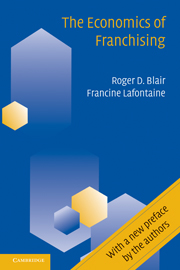Book contents
- Frontmatter
- Contents
- Preface
- 1 Introduction
- 2 Four Popular Misconceptions about Franchising
- 3 Franchise Contracts
- 4 Franchising, Vertical Integration, and Vertical Restraints
- 5 Quality Control
- 6 Franchise Tying Contracts
- 7 Vertical Price Controls in Franchising
- 8 Encroachment
- 9 Advertising and Promotion
- 10 Termination and Non-Renewal
- 11 Concluding Remarks
- Articles, Books, and Other Publications
- Cases, Codes, and Statutes
- Index
6 - Franchise Tying Contracts
Published online by Cambridge University Press: 24 May 2010
- Frontmatter
- Contents
- Preface
- 1 Introduction
- 2 Four Popular Misconceptions about Franchising
- 3 Franchise Contracts
- 4 Franchising, Vertical Integration, and Vertical Restraints
- 5 Quality Control
- 6 Franchise Tying Contracts
- 7 Vertical Price Controls in Franchising
- 8 Encroachment
- 9 Advertising and Promotion
- 10 Termination and Non-Renewal
- 11 Concluding Remarks
- Articles, Books, and Other Publications
- Cases, Codes, and Statutes
- Index
Summary
Introduction
A tying contract is a vertical restraint that involves a conditional sale. In its simplest form, the producer of product A agrees to sell that product, but only on the condition that the buyer also purchase product B. In this scenario, product A is the tying good while product B is the tied good. The situation can be more complicated, involving possibly a collection of tied goods rather than just one. Moreover, tying may involve services and other intangibles, or extend to leases as well as sales. Finally, the tying arrangement may involve third parties, that is, the buyer of A may have to buy the tied good B from a designated third party rather than from the seller of A. In all of these scenarios, however, the essence of tying is the condition that limits the buyer's freedom to purchase the tied good(s) wherever he deems optimal from his own perspective.
In the franchising context, the alleged tying good is usually the franchise license, which is normally subject to intellectual property protection. The tied goods may be other goods that are resold with little modification or they may be inputs into the production of a final good. An example of the former would be branded products such as Baskin-Robbins ice cream or Shell gasoline. The Baskin-Robbins franchisor licenses its franchisee on the condition that it buy Baskin-Robbins ice cream for resale.
- Type
- Chapter
- Information
- The Economics of Franchising , pp. 139 - 173Publisher: Cambridge University PressPrint publication year: 2005



